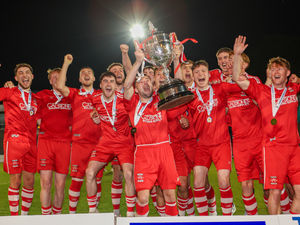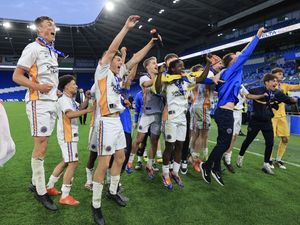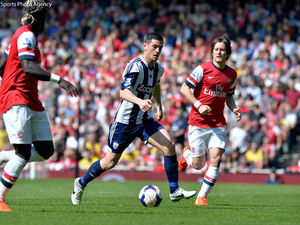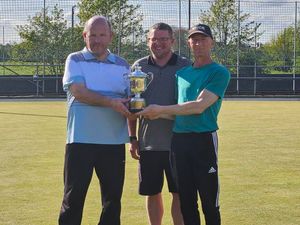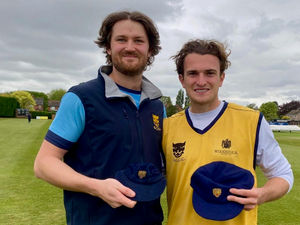How Shropshire helped England win the World Cup
Full of hope and expectation, this was the 1966 England World Cup squad settling into their Shropshire training base exactly 50 years ago today.
This picture was taken on June 7, 1966 at Lilleshall, where Alf Ramsay plotted his way to glory. Inspired by the no-nonsense manager and inspirational captain Bobby Moore, the squad were about to become heroes.
By coincidence, the anniversary of the Lilleshall training camp comes as the 2016 Euros squad settle into their luxurious base in France.
While members of today's England squad are attracting frenzied media attention, their counterparts 50 years ago barely raised an eyebrow among locals in Shropshire. They came, they played around a bit, and they conquered.

But Ball, Charlton, Hurst & co didn't make the front page when this World Cup squad destined for glory came to Shropshire exactly 50 years ago as England boss Alf Ramsey put the finishing touches to his team.
Actually, they didn't even make the front page of the Shropshire Star after the World Cup victory on July 30, 1966, which has been talked about ever since.
It was not that the Shropshire Star missed the story. Indeed, after England's epic win at Wembley we did have a World Cup story on the front page – about holidaymaker Eric Edwards, from Trench, who had won a cow by betting on an English win and was having trouble getting it home from Holland.
Indifference? No, it was simply that back then there was a lot less razzmatazz and sport was for, well, the sports pages.
It is an interesting comparison to today as today's England squad settle in to their French training base with the world's press in attendance.
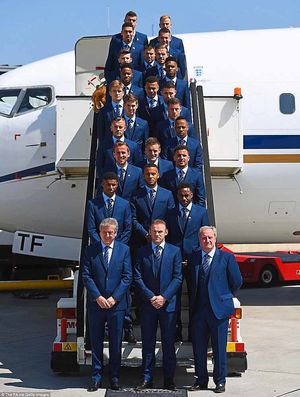
Footballers today are highly-paid global superstars forever in the public eye, and England's prospects in Euro 2016 are being discussed amid a blaze of publicity.
Prepare yourself for headlines like "England Expects". And if England make the final, it will be a good time to go on a distant holiday if you don't like football, as there will be saturation coverage across the media.
Not so in 1966. It was on Monday, June 6 that Ramsey's (he was not Sir Alf yet) initial squad of 27 players arrived at the National Sports Centre at Lilleshall to be put through their paces in the Shropshire countryside, cut off from the outside world and away from the gaze of public and press.
The next 11 days were to shape sporting history, as Ramsey was able to whittle down the squad to his provisional 22 for the World Cup competition due to start only a few weeks later.
And it was here that he polished the "wingless wonders" tactics which were to prove so successful.
This minor footballing revolution had begun at a previous get-together of the squad at Lilleshall in February 1965 – albeit with some key players like Bobby Charlton missing – when Ramsey first tried a 4-3-3 formation, using midfielders instead of wingers to mount attacks. It was then introduced gradually so, by the time of the pre-World Cup session, the players were familiar with it.
Lilleshall Hall was used to seeing football stars, England's arrival in the summer of 1966 coming not long after Sheffield Wednesday had trained there before the FA Cup final (they lost to Everton), and others including Chelsea and Manchester City. They were attracted for various reasons, including the good indoor facilities and the ability to escape publicity and concentrate on the job in hand.
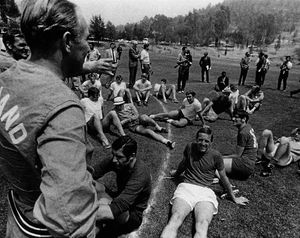
The isolation was such that Nobby Stiles, whose second son was born while he was at Lilleshall, was not able to see his newborn until he left Shropshire.
"The facilities here are first class. I can't name anything which they haven't got," said one of the squad, Wolves' Ron Flowers. Players had access to films and activities like golf, tennis and volleyball.
The first week at Lilleshall was devoted to fitness training, and the second week to football. The regime was: bell at 8.30am, breakfast at 9, training at 10.30, break at 12.30 with lunch at 1pm, training at 3, a cuppa at a biscuit at 4.30, and more work before dinner at 7, followed by recreational games or films. Ramsey did not insist on a curfew, but said that the players started to move away to bed at about 10.30pm.
It was the toughest regime that the players had experienced. Initially in practice sessions players were worried about ruining somebody else's chances through a mistimed tackled. Ramsey gave them a dressing down for holding back.
There were injury worries. It was not a tackle which did for Bobby Tambling – he fell down a bank when chasing a ball. Ray Wilson had a recurrence of a back injury.
Some of the flavour of the time is given by some anecdotes in author Leo McKinstry's biography of Sir Alf Ramsey
Jack Charlton nicknamed it "the gulag" and some players, noticing that Catholics like Nobby Stiles were allowed out to attend Mass on Sunday, asked if they could go to an Anglican church.
"No need for that," said Alf. "The warden of Lilleshall happens to be a lay preacher. If you want, I shall arrange for him to conduct a service."
With those words, the enthusiasm for religious worship suddenly disappeared, McKinstry says.
One day Stiles and Alan Ball, together with John Connelly, made a furtive trip across Lilleshall golf course for a pint at the clubhouse bar.
They were caught and paraded before Ramsey. "I didn't say you couldn't go to the bar. I didn't say you shouldn't go. I just expected you wouldn't go. We are here on serious business and I thought you all understood that. We are going to win the World Cup," Ramsey told them.
The squad left Shropshire on June 17. All were fit to play. And on that day Ramsey announced the 22 players who would be taking part in a pre-tournament warm-up competition in Scandinavia. Although it was not the official final 22 – that had to be named on July 2 – the names of the squad will be familiar to England fans who can remember the team's glorious 1966 campaign.
The full party chosen after the Lilleshall session was: Goalkeepers: Banks (Leicester), Bonetti (Chelsea), and Springett (Sheffield Wednesday).
Fullbacks: Armfield (Blackpool), Cohen (Fulham), Wilson (Everton), G. Byrne (Liverpool).
Half backs: Stiles (Manchester United), Peters, (West Ham), J. Charlton (Leeds), Flowers (Wolves), Moore (West Ham), Hunter (Leeds).
Forwards: Paine (Southampton), Callaghan (Liverpool), Greaves (Spurs), Hunt (Liverpool), Hurst (West Ham), R. Charlton (Manchester United), Ball (Blackpool), Eastham (Arsenal), and Connelly (Manchester United).
Alan Ball, who was to prove one of the stars of the final, was something of a local lad, having developed his football talents during his Oswestry days, and whose dad was manager of Oswestry Town for five years.
Everything was coming together. Greatness beckoned.

